Chinese Medicine, Succinum, Ameliorates Cognitive Impairment of Carotid Artery Ligation Rats and Inhibits Apoptosis of HT22 Hippocampal Cells via Regulation of the GSK3β/β-Catenin Pathway
- PMID: 35784758
- PMCID: PMC9240707
- DOI: 10.3389/fphar.2022.867477
Chinese Medicine, Succinum, Ameliorates Cognitive Impairment of Carotid Artery Ligation Rats and Inhibits Apoptosis of HT22 Hippocampal Cells via Regulation of the GSK3β/β-Catenin Pathway
Abstract
Succinum is an organic mineral formed from the resin of ancient coniferous and leguminous plants, which is applied for tranquilizing mood, promoting blood circulation, and removing blood stasis in Chinese medicine. For quite a long time, the modern research of succinum mainly focuses on the study of physical and chemical properties and authenticity identification while few reports on its medicinal mechanism. In current study, we evaluated different solvent extracts of succinum on carotid artery ligation rats mimicking vascular dementia. It was found that ethyl acetate extracts of succinum significantly improved the learning and memory abilities of model rats and inhibited neuronal apoptosis in the hippocampus. On a mice hippocampal neuronal cell line (HT22), ethyl acetate extracts of succinum also exerted better action trend in inhibiting cell apoptosis induced by oxygen glucose deprivation (OGD). By using XAV-939 on both in vivo and in vitro studies, it was found that ethyl acetate extracts of succinum might exert these functions by regulating the GSK3β/β-catenin pathway. These studies revealed the neuronal function of succinum, which explained the traditional effects of succinum and provided more modern scientific basis for its clinical application.
Keywords: Wnt/GSK3β; apoptosis; mineral medicine; succinum; vascular dementia.
Copyright © 2022 Wei, Zhu, Zheng, Lu, Cao, Qu, Liu, Meng, Lou, Wang, Duan, Shang, Han and Zhu.
Conflict of interest statement
The authors declare that the research was conducted in the absence of any commercial or financial relationships that could be construed as a potential conflict of interest.
Figures
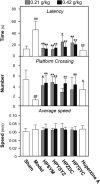




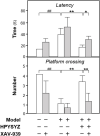
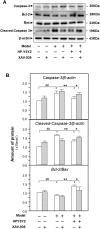
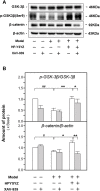

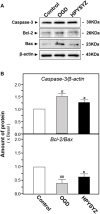
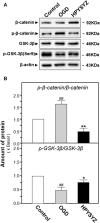

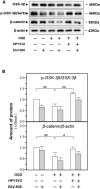
Similar articles
-
Mild hypothermia protects against oxygen glucose deprivation/reoxygenation-induced apoptosis via the Wnt/β-catenin signaling pathway in hippocampal neurons.Biochem Biophys Res Commun. 2017 May 13;486(4):1005-1013. doi: 10.1016/j.bbrc.2017.03.153. Epub 2017 Mar 30. Biochem Biophys Res Commun. 2017. PMID: 28365156
-
XQ-1H regulates Wnt/GSK3β/β-catenin pathway and ameliorates the integrity of blood brain barrier in mice with acute ischemic stroke.Brain Res Bull. 2020 Nov;164:269-288. doi: 10.1016/j.brainresbull.2020.08.032. Epub 2020 Sep 8. Brain Res Bull. 2020. PMID: 32916221
-
DIXDC1 prevents oxygen-glucose deprivation/reoxygenation-induced injury in hippocampal neurons in vitro by promoting Wnt/β-catenin signaling.Eur Rev Med Pharmacol Sci. 2018 Sep;22(17):5678-5687. doi: 10.26355/eurrev_201809_15835. Eur Rev Med Pharmacol Sci. 2018. PMID: 30229845
-
Knockdown of lncRNA TUG1 inhibits hippocampal neuronal apoptosis and participates in aerobic exercise-alleviated vascular cognitive impairment.Biol Res. 2020 Nov 19;53(1):53. doi: 10.1186/s40659-020-00320-4. Biol Res. 2020. PMID: 33213523 Free PMC article.
-
Isorhamnetin Alleviates High Glucose-Aggravated Inflammatory Response and Apoptosis in Oxygen-Glucose Deprivation and Reoxygenation-Induced HT22 Hippocampal Neurons Through Akt/SIRT1/Nrf2/HO-1 Signaling Pathway.Inflammation. 2021 Oct;44(5):1993-2005. doi: 10.1007/s10753-021-01476-1. Epub 2021 May 17. Inflammation. 2021. PMID: 33999329
Cited by
-
Multifaceted role of nitric oxide in vascular dementia.Med Gas Res. 2025 Dec 1;15(4):496-506. doi: 10.4103/mgr.MEDGASRES-D-24-00158. Epub 2025 Apr 29. Med Gas Res. 2025. PMID: 40300885 Free PMC article. Review.
-
Succinum extracts inhibit microglial-derived neuroinflammation and depressive-like behaviors.Front Pharmacol. 2022 Aug 16;13:991243. doi: 10.3389/fphar.2022.991243. eCollection 2022. Front Pharmacol. 2022. PMID: 36052132 Free PMC article.
References
-
- Abe T., Kobayashi M., Okawa Y., Inui T., Yoshida J., Higashio H., et al. (2016). Yeast Ca(2+)-Signal Transduction Inhibitors Isolated from Dominican Amber Prevent the Degranulation of RBL-2H3 Cells through the Inhibition of Ca(2+)-Influx. Fitoterapia 113, 188–194. 10.1016/j.fitote.2016.07.018 - DOI - PubMed
-
- Cheng J., Shen W., Jin L., Pan J., Zhou Y., Pan G., et al. (2020). Treadmill Exercise Promotes Neurogenesis and Myelin Repair via Upregulating Wnt/β-catenin S-ignaling P-athways in the J-uvenile B-rain F-ollowing F-ocal C-erebral I-schemia/reperfusion. Int. J. Mol. Med. 45, 1447–1463. 10.3892/ijmm.2020.4515 - DOI - PMC - PubMed
LinkOut - more resources
Full Text Sources

